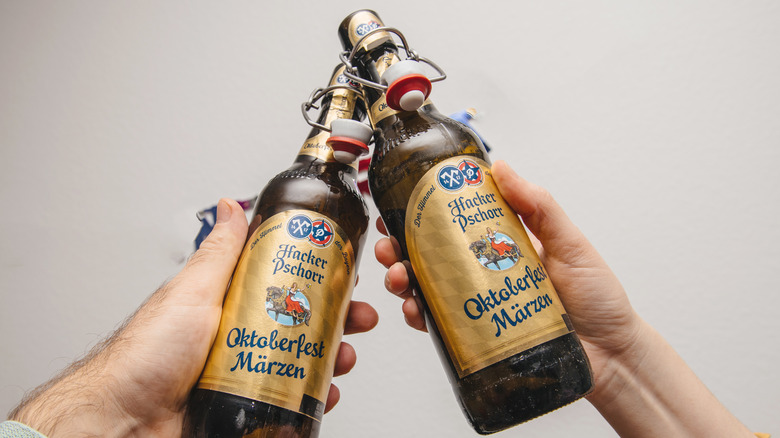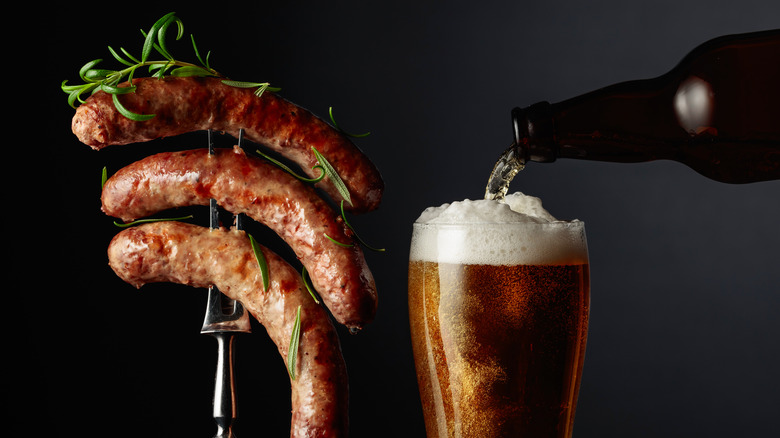What's The Difference Between Märzen Beer And Other Lagers?
Beer has undergone much experimentation since it was first made thousands of years ago by Sumerians in ancient Mesopotamia, evolving with the ingredients available to various cultures. In ancient Egypt, for instance, brewers would flavor the beverage with eccentric additives, such as olive oil and mandrake. As time has passed, beer has continued to be an essential part of many cultures, so it makes sense that there are numerous types, each with its own appearance and flavor profile. Märzen beer is one of these, and it has a few characteristics that make it stand out from other lagers.
As a German lager, Märzen or Märzenbier, which translates to "March beer," can range from amber-orange in color to deep reddish-copper — rating from 10 to 25 on the European Brewery Convention color scale — with an off-white foam. Other lagers can be pale to golden and dark brown to black, rating lower and higher on the EBC color scale respectively.
German versions customarily use Munich malt, which is very aromatic, while the grains or grist used in other countries can vary. The flavor profile is bready, slightly sweet, toffee-like, and rich yet clean with a dry finish. It's less hoppy than Czech amber lager, not as rich as Dunkles Bock, less hoppy and dry than Vienna lager from which it descends, but richer than the current Oktoberfest standard, Festbier.
The history of Märzen beer and Oktoberfest
The histories of the Märzen and Vienna lagers are intertwined in the professional relationship between Munich master brewer Gabriel Sedlmayr at Spaten Brewery and Viennese beermaker Anton Dreher at his family brewery. During the early to mid-19th century, Dreher combined new brewing innovations with the lagering knowledge he learned from Sedlmayr, which led to the creation of Vienna lager.
Then, Sedlmayr's son Josef adapted that recipe to develop Märzen beer in 1841, and he debuted it at Oktoberfest that year as the first Märzenbier-labeled lager — alongside Dreher's Vienna lager. The annual celebration had already become cemented as a tradition, started by Crown Prince Ludwig I of Bavaria after his October 1810 wedding.
At the time, beer was only brewed between late September and late April to avoid bacteria growth during the summer season, so March beer was made slightly stronger than other beer and lagered for a longer shelf life, which is where the name came from. Generally, Märzen is lagered for six to eight months, while the Vienna brew is lagered for one or two months — both at near-freezing temperatures.
The Märzen and Vienna lagers quickly became popular because of the annual event, and many breweries started making them. When the Oktoberfest attendees started running out of beer during the 1872 celebration, Spaten Brewery served its Oktoberfestbier, which turned into a tradition until Festbier became the standard in 1990.
Food pairings and cooking with Märzen beer
Whether you want to drink beer with a meal or use it to enhance cooking, there are many ways to enjoy Märzen. If you're looking at how to pair food and beer, start with dishes that complement the brew's slightly sweet and bready flavor. Some examples include bratwurst or sausages, baby back or spare ribs, pork schnitzel, and marinated grilled chicken. Even the saltiness of different bacon varieties can enhance the flavors of Märzen beer. You can pretty much pair it with all types of meats.
The possibilities for using Märzen beer in your recipes are practically endless, too. This beer is the perfect addition to marinades and makes a delicious smoked Märzen cheddar dip for salty pretzels, tortilla chips, french fries, and tater tots. Another option is to upgrade your chili with this boozy ingredient. Simply replace the chicken broth in white chicken chili with an equal amount of Märzen beer. Whichever way you incorporate it into your meal, you'll enjoy the rich flavor it imparts.


